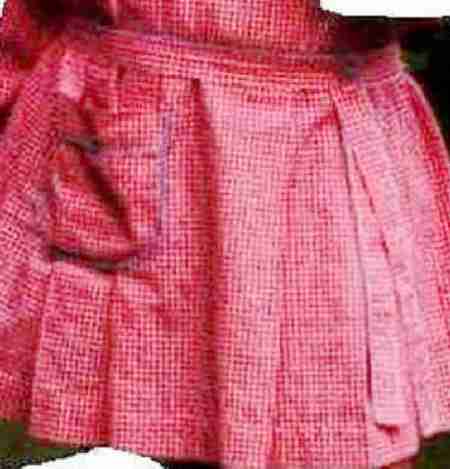
Swiss School Smocks: Belts

Figure 1.--These two Geneva boys were photographed in their school smocks about 1985. Notice the younger boy has a back buttoning smock and the older boy has a side buttoning smock. Note how the pockets can not be seen in this photograph. Also note the different beltin arrangements on the two smocks.
|
Swiss school smocks had a wide the variety of belts. Available photographs of smocks often do not show the belting arangement as the belt is in fact fastened or tied behind the smock and not visable from the front. Some smocks have a sewn-in belt whose main function was to keep correctly in place the pleating. Some of the back buttoning smocks had also a loose belt that could be on back side with either a button or belt would be tied up making a knot, in which case some boys would do such complicated knots that only their mothers could untie them.
French Translation
As a help to our French readers, we a providing a translation of the summany paragraph. French readers have expressed a special interest in smocks. Of course there commements in French or English would be appreciated: Afin de faciliter la lecture à nos visiteurs francophones nous avons traduit et complété le paragraphe d'introduction en français. En effet de nombreux lecteurs de langue française ont manifesté un grand intérêt pour ces pages sur les tabliers d'école et nous les invitons à nous faire tenir leurs commentaires et expériences propres. Les tabliers d'école en Suisse romande avaient une grande variété de ceintures. Les photographies disponibles ne montrent pas suffisament le détail de la ceinture, celle-ci étant de fait souvent nouée dans le dos. Quelques tabliers comportent une ceinture cousue sur le tissu du tablier, couture dont la fonction principale était de garder correctement en place le plissage. Les tabliers boutonnés dans le dos pouvaient également comporter une ceinture libre attachée soit par un bouton sur le devant, soit dans le dos par un noeud. Dans ce cas il advenait souvent que le garçon nouant lui-même sa ceinture faisait un noeud si compliqué que seule sa mére pouvait le dénouer.
Various Arrangements
Swiss school smocks had a wide the variety of belts. Some smocks have a sewn-in belt whose main function was to keep correctly in place the pleating.
Back-buttoning smocks
Some of the back buttoning smocks had a loose belt that could be on back side with either a button or belt or sash which would be tied up making a knot. Backbuttoning smocks could either have the belt
with knot on the back, particularly when belt was sewn on smock (sewing was only on front part and the back part remains free to make the knot). There was also a completely free belt of two types. The first type was just the size of waist line, closing then with a button. The second type was the longer, requiring either the knot or
having as well a button (figure 2). This type of belt/sash creating a decorative effect with the two belt ends falling down below button. Obviously with the longer belt requiring knot, you could have knot on the back or in front, in which case the result is not so nice as the belt about 3-4 cm width will not be neatly applied against smock around the knot.
Side buttoning smock
Side buttoning smocks, be it right or left were usually made with
a loose belt tied up with a button on same side as actual buttoning.
Would the smock be of the pleated type, the belt would in many
cases be sawn directly on the smock in order to preserve nicely
the pleating.
Pinafore or apron smock
Pinafore or apron smocks did not have belts.

Figure 2.--This detail from a red gingham, back byttoning smock shows the blue detailing on the pocket and belt.
|
Color and Material
The color and material of the smock belt was almost always the smae as the smock itself. Sometimes the belt might have a little colored trim, but almost always the belt itself was the same color and material as the rest of the smock.
Difficulty Determining
Assssing belting types from photographs is difficult. Available photographs of smocks often do not show the belting arangement as the belt is in fact fastened or tied behind the smock and not visable from the front. Also the fact that the belt is the same color and material makes it difficult to detect.
Tieing Knots
Tieing the knot to secure your smock behind your back was not an easy task. It was like tie shoe laces or a tie, it took a bit of leaning. For younger boys it was mother would made the knot. If undone at school it would be the lady teacher who would redo the knot
(Note on the gender of teachers in Switzerland. Up to about 8 years old, the boys had ladies as teachers. Thereafter it was always men. here was for primary level one single teacher for the entire program, including singing or gymnastics. In the secondary level you had a teacher for each branch). As boys got older, they would work on tieing their own knots. In which case some boys would do such complicated knots that only their mothers could untie them when they got home. .
Older boys were able to make that knot on the back without difficulty.
Christopher Wagner

Navigate the Boys' Historical Clothing Smock pages:
[Return to the Main Swiss school smock pages]
[American]
[Argentine]
[Bolivia]
[English]
[French]
[Jamaican]
[Portuguese]
[Spanish]
[Swiss]
[Turkish]
Navigate the Boys' Historical Clothing Smock-related pages:
[Pinafores]
[Fauntleroy suits]
[Fauntleroy dresses]
[Sailor hats]
[Park outings]
[French page]
[Renoir page]
[School smocks]
Navigate the Boys' Historical Clothing Web Site:
[Introduction]
[Activities]
[Biographies]
[Bibliographies]
[Chronology]
[Clothing styles]
[Contributions]
[Countries]
[Boys' Clothing Home]
Created: December 21, 2000
Last updated: December 21, 2000




